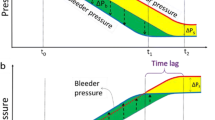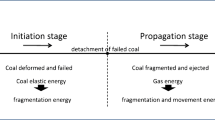Abstract
Gas explosions or mine fires present the safety threats for coal miners or mine rescues members. For an explosive atmosphere in the underground mine, careful determination of its explosibility status and applying some mitigations to switch an explosive atmosphere into a non-explosive one are very important for any underground rescues or a mine fire extinguishment. However, due to the complicated compositions in an underground sealed atmosphere, accurate determination of the explosibility of such atmosphere status is always a knotty problem for mining engineers. Beside of that, a proper estimation method for the needed time span when an explosive atmosphere is artificially or naturally changed into a non-explosive is also urgently desired. In order to improve the mine safety, this paper is going to address such mentioned problems. The original Coward explosibility diagram is modified with handling the combination effects of different inert gases for more accurate determining the explosibility of an underground sealed atmosphere which consists of complex gas compositions. Then, based on the revised explosibility diagram, a set of mathematical equations are theoretically derived to estimate the inertisation time of a sealed mine atmosphere by using different inerting approaches. Such research efforts can help mine operators understand the risk and provide a tool to control such atmosphere away from dangerous conditions. In order to demonstrate the research findings, at the end of the paper, the explosibility of gas sample taken from a real mine has been analyzed by using the revised Coward diagram. Also, the different inertisation time durations of various mitigation measures for such underground atmosphere have also been calculated.




Similar content being viewed by others
References
Bjerketvedt D, Bakke JR, Wingerden KV (1997). Gas explosion handbook. J Hazard Mater 52(1):1–150.
CDC (2009) Morb Mortal Wkly Rep 57(51):1379–1383.
Cheng J, Luo Y (2013) Modified explosive diagram for determining gas-mixture explosibility. J Loss Prev Process Ind 26(4):714–722.
Cheng J, Luo Y, Zhou F (2013) Explosibility safety factor: an approach to assess mine gas explosion risk. Fire Technol. doi:10.1007/s10694-013-0324-y.
Cheng J, Wang C, Zhang S (2012) Methods to determine the mine gas explosibility—an overview. J Loss Prev Process Ind 25(3):425–435.
Coward HF, Jones GW (1952) Limits of flammability of gases and vapors. US Bureau of Mines, Bulletin 503, US Government Printing Office, p 153.
Greuer R (1974) Study of mine fire fighting using inert gases. US Bureau of Mines Contract Report No. S0231075, p 135.
Holding W (1992) A re-look at explosibility diagrams. In Proceedings of the 5th International Mine Ventilation Congress, Johannesburg, Republic of South Africa, Hemp R (ed), pp. 171–181.
Hartman HL, Mutmansky JM, Ramani RV, Wang YJ (1997) Mine ventilation and air conditioning. Wiley, New York.
Huang S (2010) China coal outlook 2010. China Coal Industry Publishing House, Berijing.
McPherson MJ (1993) Subsurface ventilation and environmental engineering. Chapman & Hall, London, pp (21)39–(21)43.
Ma T, Larrañaga M (2013) Theoretical flammability diagram for analyzing mine gases. Fire Technol. doi:10.1007/s10694-013-0355-4.
Ma T, Wang Q, Larrañaga M (2013) From ignition to suppression, a thermal view of flammability limits. Fire Technol. doi:10.1007/s10694-013-0338-5.
Pandey J, et al (2012) Investigation of the role of fire retardants in preventing spontaneous heating of coal and controlling coal mine fires. Fire Technol. doi:10.1007/s10694-012-0302-9.
Perera I, Litton C (2012) Impact of air velocity on the detection of fires in conveyor belt haulage ways. Fire Technol 48(2):405–418.
Ray SK, Singh RP (2007). Recent developments and practices to control fire in underground coal mines. Fire Technol 43(4):285–300.
Acknowledgements
This work is financially supported by grants from the Fundamental Research Funds for Central Universities (Grant No. 2013QNA01), the National Science Foundation of China (Grant No. 51304203) and the Natural Science Foundation of Jiangsu Province of China for Youths (Grant No. BK20130191); the Program for Changjiang Scholars and Innovative Research Team in University (IRT13098) and Priority Academic Program Development of Jiangsu Higher Education Institutions the authors are grateful for these supports.
Author information
Authors and Affiliations
Corresponding author
Rights and permissions
About this article
Cite this article
Cheng, J., Zhou, F. Revised Explosibility Diagram to Judge Best Practice of Controlling an Explosive Gas-Mixture. Fire Technol 51, 293–308 (2015). https://doi.org/10.1007/s10694-014-0387-4
Received:
Accepted:
Published:
Issue Date:
DOI: https://doi.org/10.1007/s10694-014-0387-4




